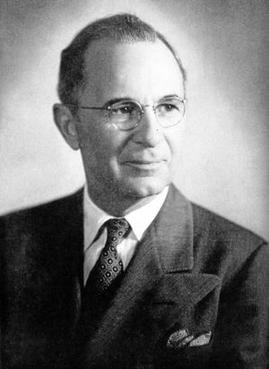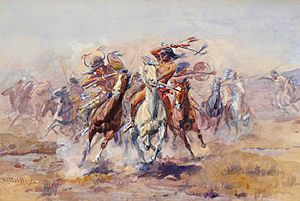Thomas Gilcrease facts for kids
Quick facts for kids
Thomas Gilcrease
|
|
|---|---|
 |
|
| Born |
William Thomas Gilcrease
February 8, 1890 |
| Died | May 6, 1962 (aged 72) |
| Nationality | Muscogee (Creek) Nation, American |
| Occupation | Oilman |
| Years active | 1922–1962 |
| Known for | Founder of Gilcrease Museum |
| Spouse(s) | |
| Children | 3 |
William Thomas Gilcrease (born February 8, 1890 – died May 6, 1962) was an important Muscogee-American oilman, art collector, and generous giver (philanthropist). During his life, Gilcrease gathered a huge collection of over 10,000 artworks. He also collected 250,000 Native American artifacts and 100,000 rare books and documents. This included a special copy of the Declaration of Independence. He is famous for starting the Gilcrease Museum in Tulsa, Oklahoma. In 1971, he was honored in the Hall of Great Westerners.
Contents
Biography
Early Life and Education
Thomas Gilcrease was born in Robeline, Louisiana, on February 8, 1890. His mother, Mary "Elizabeth" Vowell Gilcrease, was a member of the Muscogee Nation. Soon after he was born, his family moved to Indian Territory. They wanted to get land given to tribal members. They settled near Eufaula, Oklahoma. His father ran a cotton gin nearby in Mounds, Oklahoma.
Thomas had limited schooling in one-room schools. People sometimes called him "Indian Tom." He went to Bacone College. There, his teacher, Alexander Posey, taught him about arts, sciences, writing, and his Native American heritage. He learned about the Trail of Tears and leaders like Sequoyah and Sitting Bull. He also learned how to make bows and arrows and hunt.
After Bacone College, Gilcrease went to Kansas State Teacher's College. This school is now called Emporia State University.
Becoming an Oilman
Around 1900, the government changed how land was owned in Indian Nations. At age nine, Thomas Gilcrease received 160 acres of land. This was because he was 1/8 Creek. His land was about 20 miles southwest of Tulsa, Oklahoma.
In 1905, oil was discovered in that area. His land was on top of the huge Glenn Pool Oil Reserve. This made Gilcrease a multi-millionaire by the time he was twenty. He was a smart businessman. He started the Gilcrease Oil Company in 1922. With early success, he bought more land. His company headquarters moved to San Antonio, Texas, in 1937. Later, in 1949, the headquarters moved to Tulsa.
Family Life
On August 22, 1908, Gilcrease married Belle M. Harlow. She was a member of the Osage Nation. They had two sons: William Thomas Gilcrease Jr. and Barton Eugene Gilcrease. Their marriage ended in divorce in 1924.
On September 3, 1928, he married Norma Smallwood. She was 19 years old and had been Miss America 1926. Thomas and Norma had one daughter, Des Cygne Lamour Gilcrease. Their marriage ended in divorce in 1934.
Later Life and Legacy
In the 1920s and 1930s, Gilcrease was inspired by European art museums. He started collecting oil paintings and items from the American West in 1922. His collection grew a lot over the next 20 years.
In 1946, the Sioux Nation honored Gilcrease. They made him an honorary tribal member. They gave him the name Wicarpi Wakatuya, meaning "High Star."
In the 1950s, oil prices dropped. This caused financial problems for Gilcrease. He had spent a lot of money buying new items for his collection. He offered to sell his entire collection in 1954. The people of Tulsa quickly acted. They approved a bond issue to pay his debts. This kept the collection in Oklahoma.
Thomas Gilcrease passed away from a heart attack on May 6, 1962. His funeral followed traditional Indian customs. He was buried in a special building (mausoleum) on his estate. His mother was also buried there.
Art Collection
Thomas Gilcrease spent his life collecting American art, Native American art, artifacts, and documents. He began collecting art from the American West in 1922. At that time, not many people were interested in Native American or Western art. Gilcrease supported many Oklahoma artists. These included Woody Crumbo, Acee Blue Eagle, and Willard Stone. Their works are now part of the collection.
In 1943, Gilcrease moved to San Antonio. He opened the Museum of the American Indian there. This museum was also known as the Gilcrease Museum. However, not many visitors came to the San Antonio location.
In 1947, he bought the entire collection of Phillip G. Cole. This collection included many bronzes and paintings by Charles Marion Russell and Frederic Remington. It also had photographs by Edward Curtis and important historical documents.
Gilcrease hired architect Alexandre Hogue to design a museum. It was built on land he had bought in Oklahoma in 1914. In 1949, he opened the Thomas Gilcrease Institute of American History and Art on this property. Gilcrease lived in a stone home next to the museum. This home was surrounded by a garden with plants used by local tribes.
In 1954, people in Tulsa worried the museum might be sold and moved away. Citizens voted to approve $2.25 million to pay Gilcrease's debts. In return, Gilcrease gave his entire collection to the City of Tulsa in 1955. He also gave the museum buildings and grounds to the city in 1958. He promised oil money to Tulsa to help maintain the museum.
After giving the collection away, Gilcrease kept funding archaeological digs. He also continued to buy more items. These items were given to the museum when he passed away in 1962. His funeral honored his Native heritage. Chief Wolf Robe Hunt led a prayer. Arrows were shot into the air to protect his spirit. Cornmeal was sprinkled to provide food for his spirit's journey.
The Gilcrease Museum
The Gilcrease Museum is also known as the Thomas Gilcrease Institute of American History and Art. It has one of the world's largest collections of art, artifacts, and historical papers about the American West. The museum is located in Tulsa, Oklahoma.
The museum grounds have 23 acres of themed gardens. These gardens show different gardening styles from the American West. Thomas Gilcrease's home and his mausoleum are also on the grounds.
In 2016, Tulsa voters approved $65 million to renovate and expand the museum. However, it was decided that building a new museum would be better. The project became an $83.6 million plan for a completely new museum. The old building was taken down, and construction on the new one began in 2022. The new museum is expected to be finished by early 2025. Thomas Gilcrease's house and the mausoleum will remain.


